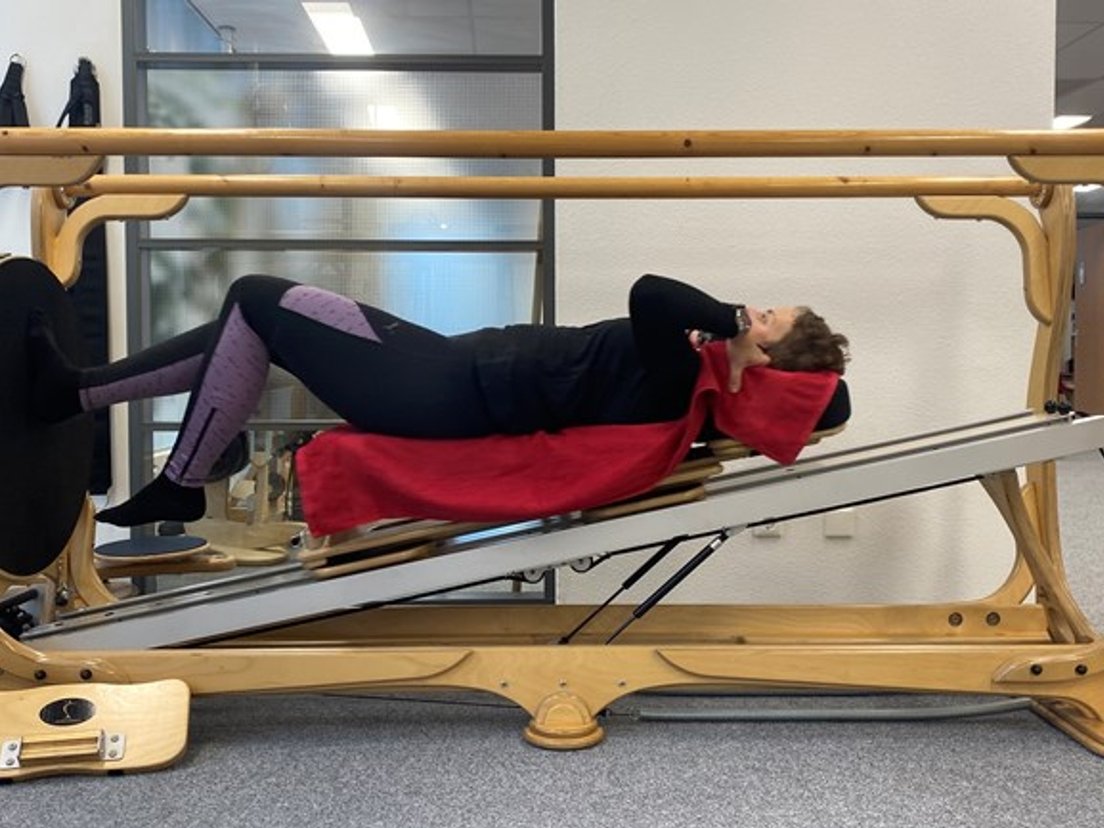Gyrotonic Rehabilitation for MS after breakthrough stem-cell treatment
Marlika crowdfunded 90,000 euros for MS treatment AND USES GYROTONIC TO REBUILD MUSCLE STRENGTH aND CONTROL.
Marlika with her husband Maurice and daughter Manouk
Your world collapses when you are told that you have MS. That happened to Marlika Michielsen from Rotterdam two years ago. She was able to finance a promising medical treatment in Russia through a fundraising campaign. With that, the disease has stopped. And it took a while, but now the recovery really continues through training and maintenance of her body… and she has to work hard.
Twice a week, 32-year-old Marlika works up a sweat under the supervision of a movement expert in Gyrotonic. It looks like fitness, but for many, it's the most ultimate form of rehabilitation. "I do it to stretch my muscles against stiffness. Because that has been problematic," says Marlika.
Marlika rebuilds muscle strength through special Gyrotonic musculoskeletal devices like the Jumping Stretching Board
At the beginning of 2019, shortly after the birth of her daughter, she developed the first symptoms of muscle loss from the disease. "I just fell out of bed and then I couldn't even put on my clothes on my own. When the Dr. diagnosed her with active MS, she thought: “oh no! I had just started a nice future with my new daughter and suddenly I am faced with a black hole.”
Multiple sclerosis (MS) is a disease that affects the nervous system. The protective layer around the nerves in the brain and spinal cord are damaged and this can cause problems with walking, feeling and seeing. In the Netherlands, like most countries, there is no specific treatment to stop or revert the disease - except that the symptoms can be controlled temporarily with medication.
stem cell treatment has aN expensive price tag
For the then 30-year-old from Rotterdam it was bad news, but not one she wanted to accept. On the internet she found information about a promising treatment in Russia in which your stem cells are removed from your body, the wrong cells are filtered out and healthy ones are replaced. This therapy intends to gives your immune system a “reboot”. This treatment comes with an expensive price tag, for which the costs are not reimbursed by health insurance. Marlika's family and friends start a fundraiser and 90,000 euros were raised in a short time - it was a surprising amount and many of the donations came from strangers - which completely stunned Marlika. "It's really incredible that so many associations, shops, schools, people close by, people I don't know at all, they all support me!" she said in the summer of 2019 just before leaving for Moscow. There she underwent a heavy six-week treatment during which she also temporarily lost her hair. With such a reset of your immune system, your defenses have to be rebuilt from scratch and that is where the danger lies. At that moment in time, you are susceptible to even the smallest of infections.
Recovery WAS harder than treatmenT
For Marlika, after returning to the Netherlands she had a difficult and slow recovery. "I thought I would be back to my old self after three months, but the recovery was definitely harder than the treatment," she says. The recovery had many ups and downs . She ended up in the hospital in early 2020 with a small infection on a finger. "You feel exhausted and bad. That is a downside." In the spring during the first COVID lockdown after she started Gyrotonic Training - things eventually started to go really well. Her perseverance and tight training schedule seemed to coincide with the turnaround. "We are now on the right track."
Her Gyrotonic trainer Francesca watches Marlika to ensure she performs all movements correctly. "The medical treatment alone is not enough, you have to support the rehabilitation with the right movements and train a lot," says Francesca. The 32-year-old from Rotterdam agrees. It is not only stopping the stem cell treatment and the disease, but also working hard on your rehabilitation. "Because of a lot of movement and training my muscles, I notice that I'm not standing still, but really moving forward. And that really makes a difference," says Marlika. It is going so well now that she carefully takes up running.
Marlika can look optimistically to the future again. She works full time again and can play and jump with her daughter without fear of dropping her. She wishes everyone who has to deal with this disease such a beautiful prospect. "My neurologist here in Rotterdam calls me a success story and that is of course a great compliment. You can see it: I can walk well again and do everything."
Letter to THE House of Representatives
In hopes of bringing the treatment to the Netherlands, Marlika wrote a letter to all members of the House of Representatives. "I have had very enthusiastic reactions to that, but the conclusion is that research must first take place in the Netherlands before these types of treatment can also be included in the care package here," she says, slightly disappointed. Marlika's letter has set something in motion, but it also requires a lot of patience. We will have to wait and see how things progress!!

